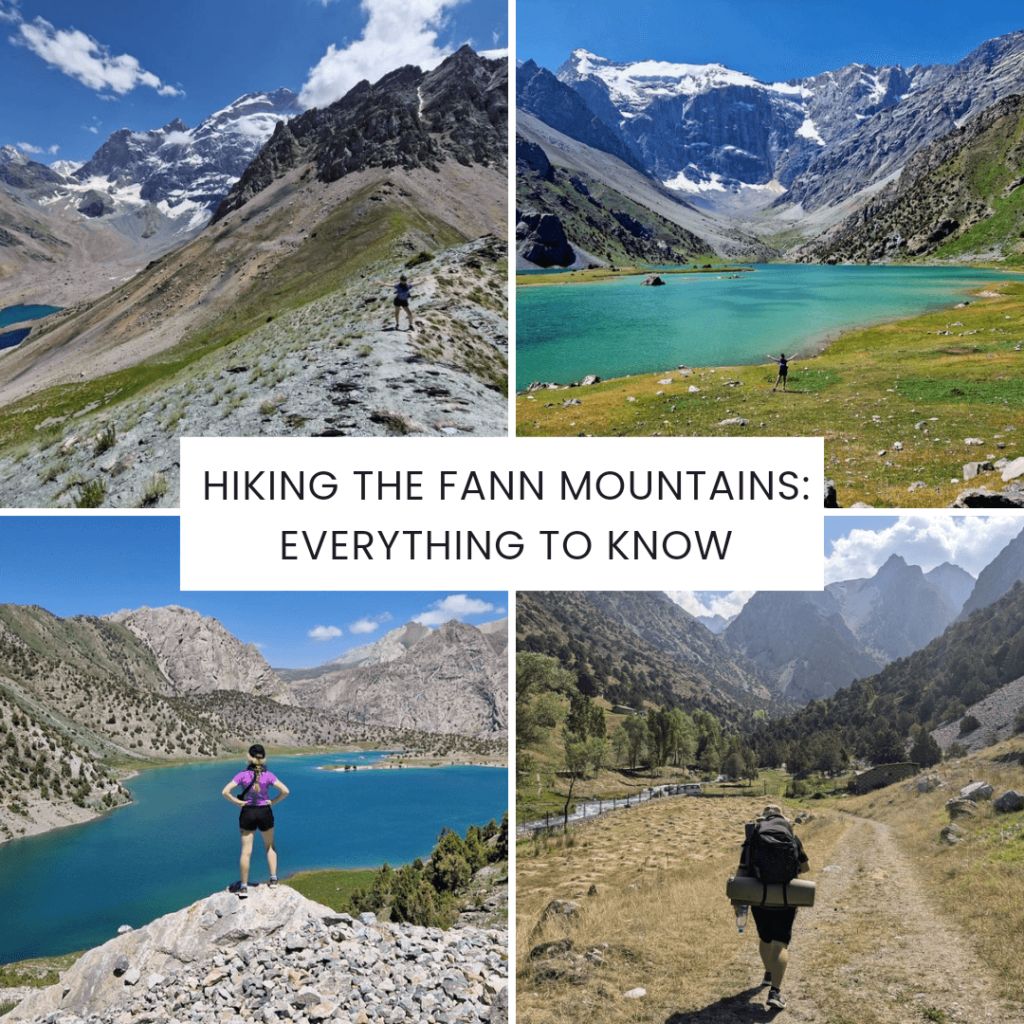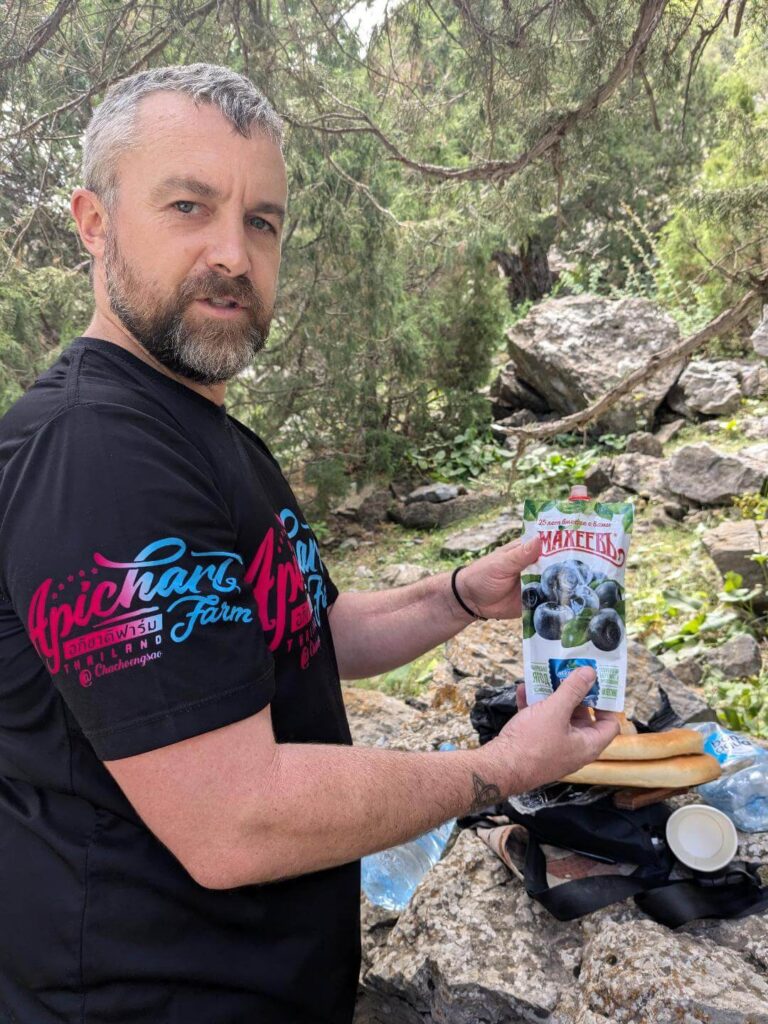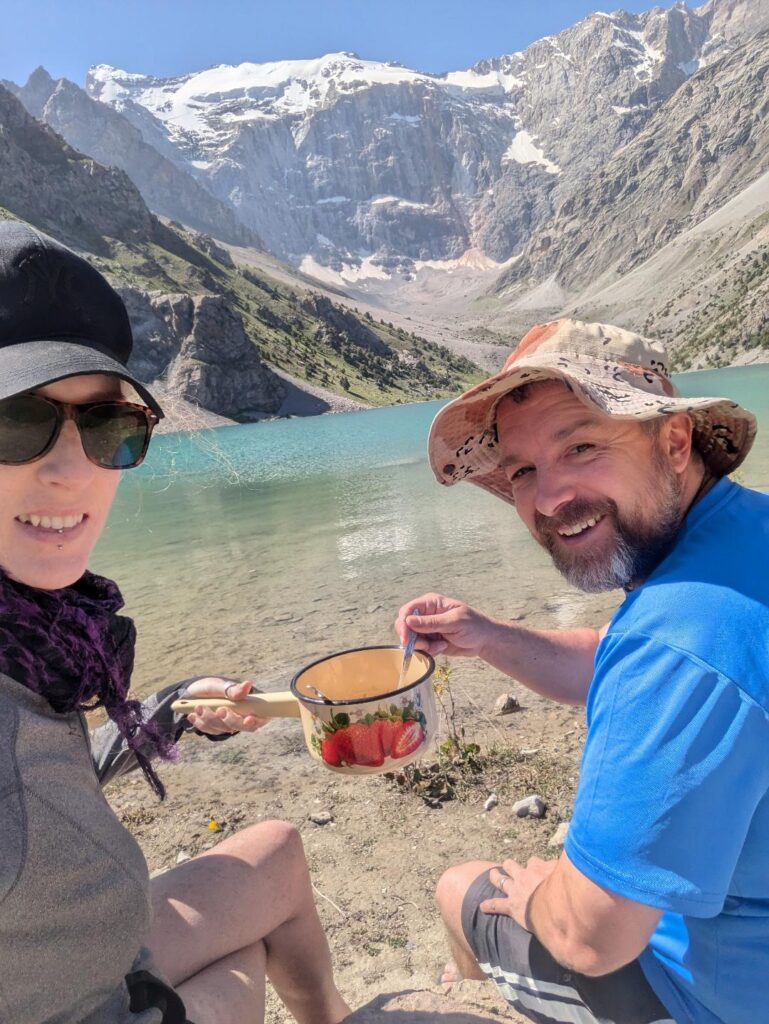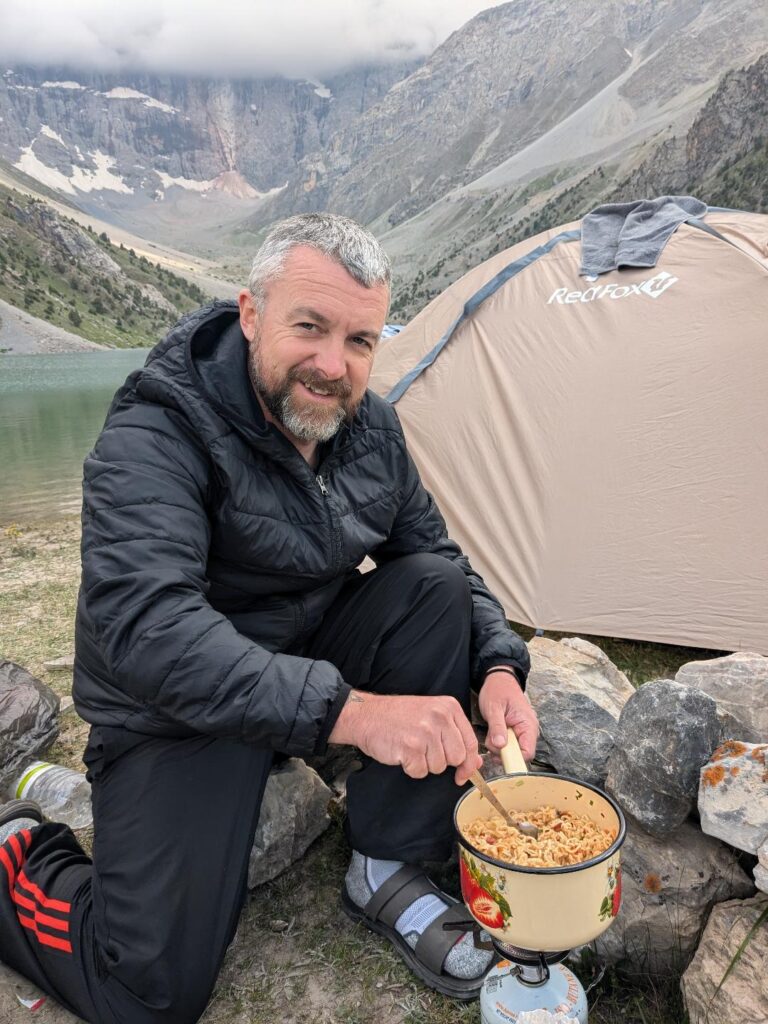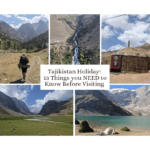Did you know that mountains cover 93% of Tajikistan’s landscape? Let’s just say if you’re seeking an unforgettable hiking adventure, you’ve found the perfect destination! We believe the Fann Mountains boast some of the world’s best hikes, and we couldn’t wait to dedicate an entire travel guide to this Central Asia gem.
We can honestly say that no photo you have seen of the Fann Mountains (even the AI ones!) does this place justice, the natural beauty of this undiscovered part of Tajikistan is like no other.
After years of full-time travel, trekking through the Fann Mountains in Tajikistan has earned the top spot in our world adventures. Hiking the Fann Mountains was incredibly beautiful, but it certainly wasn’t easy. Traveling in Tajikistan is challenging, and hiking in Tajikistan takes it to another level. That’s why we’re here to answer all your essential questions.
In this Fann Mountains guide, we compiled all the questions we asked in preparation for our 6-day Fann Mountains hike, of which we found the answers by putting in the hard work and experiencing everything first-hand. So don’t worry – you’re in good hands.
Remember to check out our YouTube video at the end of the article to find out how we hiked the Fann Mountains independently.
Hiking the Fann Mountains – All Your Questions Answered
Hiking the Fann Mountains in Tajikistan is an adventure like no other, and asking the right questions can help ensure a safe and enjoyable experience.
Here are some important questions to consider before exploring Central Asia’s best-kept secret.
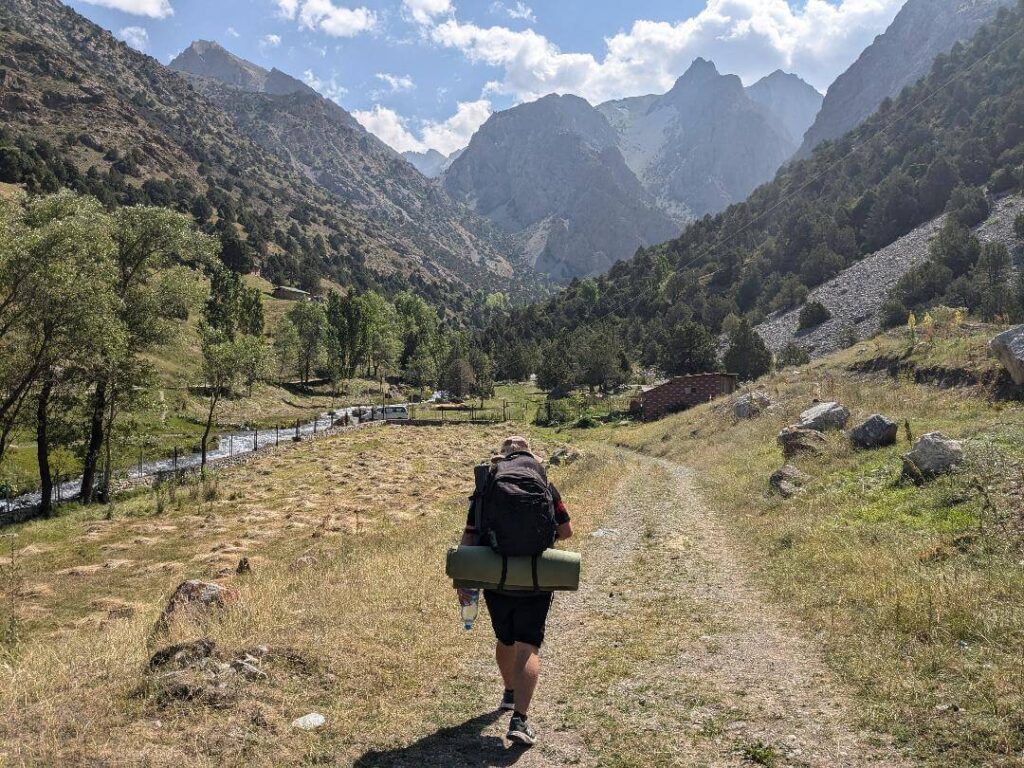
1. Where are the Fann Mountains?
A valid first question and quite important if you are to plan your Fann Mountains trek – great start!
The Fann Mountains are located in Tajikistan, a landlocked country in Central Asia, bordered by Kyrgyzstan to the north, Uzbekistan to the west and south, Afghanistan to the south, and China to the east.
While most travelers venture out into the Pamir and/or the Alay mountains in the center and east of Tajikistan, they often overlook the Fann mountains in the north-western corner of the country, just across the border from Samarkand, Uzbekistan.
If you plan on crossing the border from Uzbekistan to Tajikistan, we have all the information you will need to take on the Samarkand to Panjakent border crossing. Some of this information could save you quite a lot of money on fines so do not pass this out!
2. How do I get to the Fann Mountains?
To begin your trek in the Fann Mountains, you’ll likely start from Artuch village or Artuch base camp, which is a popular starting point for many hikes in the region.
By Air: Fly into Dushanbe International Airport, the capital of Tajikistan. From Dushanbe, you can travel to Panjakent by car or shared taxi (approximately 5-6 hours by road). Again, if you are coming from Samarkand, Uzbekistan, check out the link above.
By Road: From Dushanbe, you can take a private or shared taxi to Panjakent. The road is scenic but can be challenging, so it’s advisable to be prepared for winding mountain roads and long dark tunnels!
Alternatively, buses also connect Dushanbe to Panjakent, though they are less frequent and may take longer. These buses depart once they’re full, so it’s best to arrive early to secure a seat.
From Panjakent: If you’re coming from Panjakent (the closest city to the Fann Mountains), it’s possible to arrange transport from Panjakent to Artuch. Shared jeeps or taxis are available, and the trip takes around 2-3 hours.
Private and shared taxis wait near the bazaar/main mosque in Panjakent. To book a private car/taxi from Panjakent to Artuch base camp will cost you about 300 somoni or $27.
We arrived in Panjakent a day before we embarked on our Fann Mountain hike so we had time to ask around regarding the best options and prices of transport from Panjakent to Artuch village.

Given that we were budget travelers in Tajikistan we opted for the shared taxi from Panjakent to Artuch village for 25 somoni/ $2 per person.
There are shared taxi options available from Artuch village to Artuch camp, but they come at a cost. We’ve heard that this 7 km journey can set hikers back around $40 per person, so be prepared for the added expense if you choose to shorten the hike with this convenience. Needless to say, we chose to hike this part!
Another option is to hire a transfer offered by Artuch base camp. Inquire whether it is possible to join another group transfer to reduce the cost. From our experience in messaging the staff at Artuch Camp, they were extremely efficient and helpful.
3. What is the best time of year to hike in the Fann Mountains?
The best time to hike the Fann Mountains in Tajikistan is typically during the summer months, from late June to early September. The weather is milder during this period, and the trails are more accessible, as the snow and harsh winter conditions have cleared.

We trekked the Fann Mountains in July and, while it was cool at night, the hiking weather was perfect and mild.
4. What permits or documentation do I need to hike in the Fann Mountains?
No permit is needed to hike the Fann Mountains, however, you will require a permit to travel the Pamir Highway and if your visit to Tajikistan exceeds 10 days you will need to register at a local police station.
A top tip is to book with our recommended Panjakent accommodation and the host will help you with this. We couldn’t thank him enough!
5. How difficult is the terrain when hiking the Fann Mountains?
Trekking the Fann Mountains in Tajikistan was our first multi-day trek in Central Asia, as well as, our first experience hiking at high altitude.
The terrain when hiking in the Fann Mountains can vary in difficulty depending on the specific route, but overall, the area is known for rugged, challenging terrain that requires a moderate to high level of hiking experience.
Trail Conditions: Many Fann Mountain trails involve steep ascents, rocky paths, and exposed ridgelines. While some lower-altitude treks can be more straightforward, higher-altitude routes can involve scrambling and navigating through uneven or loose terrain.
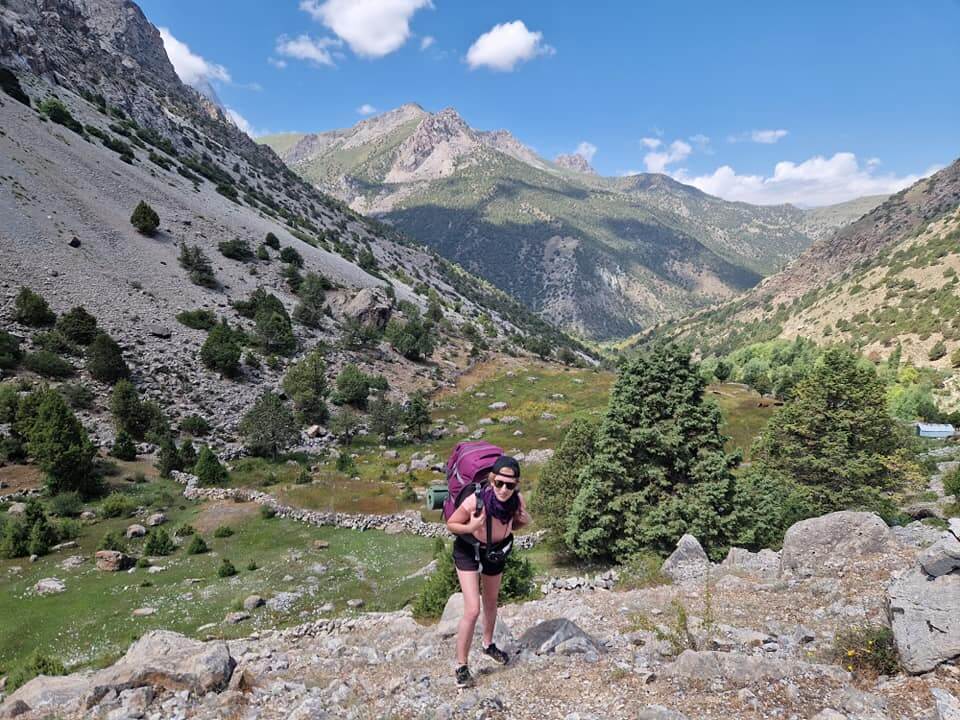
Altitude: The Fann Mountains rise above 5,000 meters (16,400 feet), and trekkers will often reach elevations of 3,000-4,000 meters (9,800-13,100 feet). This can lead to altitude sickness if you’re not acclimatized.
6. What is the Level of Experience Needed when hiking the Fann Mountains?
Intermediate to Advanced: The Fann Mountains are generally suited for trekkers with at least an intermediate level of experience in mountain hiking. You should be comfortable with long days of hiking, navigating rugged terrain, and dealing with high-altitude conditions.
Physical Fitness: Good physical conditioning is essential. Some of the routes involve multi-day treks with challenging ascents and require stamina and strength, particularly if you are carrying your own gear. If you have a donkey, you’ll be grand!
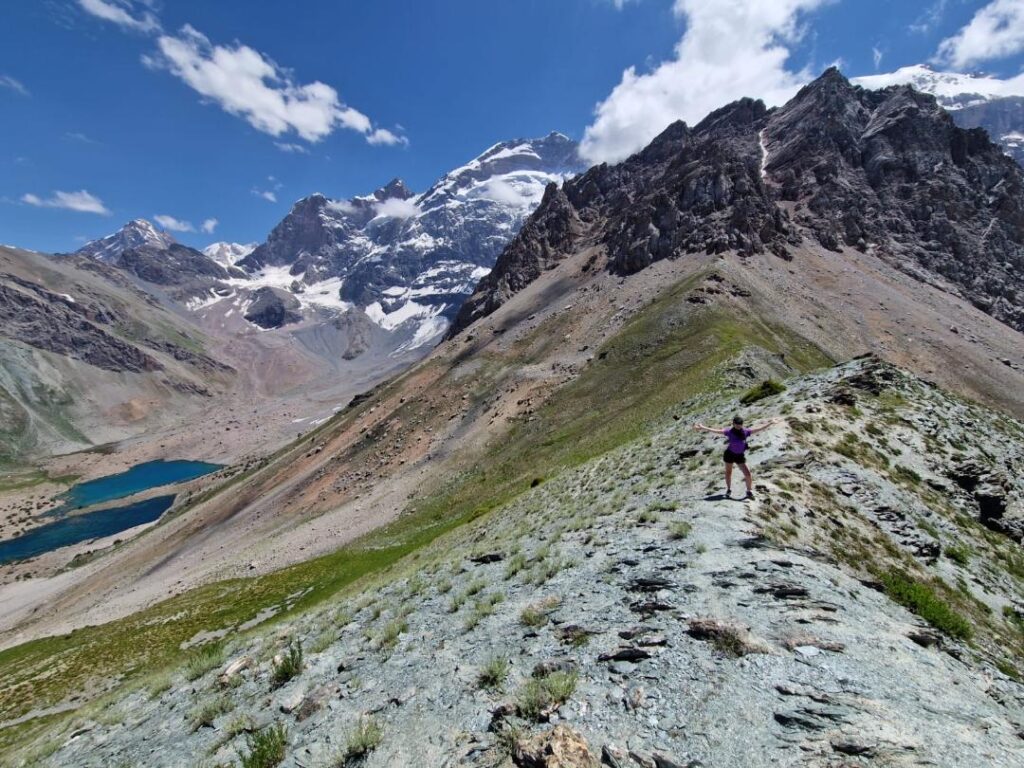
Skills: While technical mountaineering skills (like rock climbing) are not typically needed, some routes may require basic scrambling skills, and familiarity with map reading and GPS navigation is helpful. *There are no trail markings when hiking the Fann Mountains.
Guided Treks: For those with less experience, it is often recommended to hire a guide when hiking the Fann Mountains, especially for routes that go beyond popular, well-trodden paths. Guides can help with navigation, safety, and offer a more enriching experience.
During our 6-day hike in the Fann Mountains, we paced ourselves and took frequent breaks as needed. Due to the high altitude, we experienced headaches, so we added an extra night of camping to allow more time for acclimatization.
Be sure to invest in our top recommended travel insurance before hiking the Fann Mountains in Tajikistan.
7. What are the main trail options and how long do they take?
The Fann Mountains offer several popular trekking routes, each with its own level of difficulty and unique scenery. Here are the main trails in the region:
The Kulikalon Valley Trek
This was the Fann Mountain trek we opted for and it was easily one of the best hikes in the world. We often described it as a hidden Eden, nestled among the snow-capped peaks of an undiscovered Tajikistan.

- Duration: 4-6 days
- Difficulty: Moderate
- Description: This is one of the most popular trekking routes in the Fann Mountains. It takes you through the stunning Kulikalon Valley, known for its turquoise alpine lakes and dramatic mountain views. You’ll hike to altitudes of around 3,500 meters (11,500 feet). The trek is relatively accessible but still offers a challenging and scenic experience.
The Alauddin Lakes Trek
- Duration: 3-5 days
- Difficulty: Moderate to challenging
- Description: This trek takes you to the beautiful Alauddin Lakes, surrounded by snow-capped peaks. The route involves steep ascents and takes you to an elevation of around 3,800 meters (12,500 feet). Along the way, you’ll pass alpine meadows, rocky paths, and dramatic landscapes, making it one of the most stunning treks in the Fann Mountains.
The Sarvastan Pass to Iskanderkul Lake Trek
- Duration: 5-7 days
- Difficulty: Challenging
- Description: This is a more strenuous trek that crosses the Sarvastan Pass (at around 4,200 meters / 13,800 feet) before descending to the serene Iskanderkul Lake. The trek offers incredible panoramic views and a mix of challenging ascents and descents. The high-altitude pass and varying terrain make this a more demanding route suited for experienced trekkers.
Iskanderkul Lake to the Fann Mountains (via the Zaravshan Range)
- Duration: 6-8 days
- Difficulty: Challenging
- Description: This trek is for experienced hikers, taking you through the stunning landscape of the Zaravshan Range and offering spectacular views of glaciers, valleys, and lakes. The trek includes some high passes, and varying terrain, including rocky paths and alpine meadows.
The Chukurak Lakes and Sevan Pass Trek
- Duration: 4-6 days
- Difficulty: Moderate to challenging
- Description: This trail takes you through the beautiful Chukurak Lakes and over the Sevan Pass, with dramatic mountain views and several alpine lakes. The trek reaches altitudes over 3,800 meters (12,500 feet) and offers both scenic beauty and a good challenge for trekkers.
The Dushak Valley to Chapdara Valley Trek
- Duration: 4-6 days
- Difficulty: Moderate to challenging
- Description: This trek connects the Dushak and Chapdara Valleys, both of which are less visited and offer a more remote trekking experience. You’ll traverse rugged terrain, see pristine alpine lakes, and pass through traditional Tajik villages. The route reaches altitudes of around 3,500 meters (11,500 feet).
Key Features of the Fann Mountains Treks
Lakes: Many treks feature stunning lakes, such as Alauddin, Kulikalon, and Iskanderkul, which are known for their vibrant turquoise waters.
Altitude: Most treks in the Fann Mountains reach altitudes over 3,000 meters (9,800 feet), requiring good acclimatization to avoid altitude sickness.
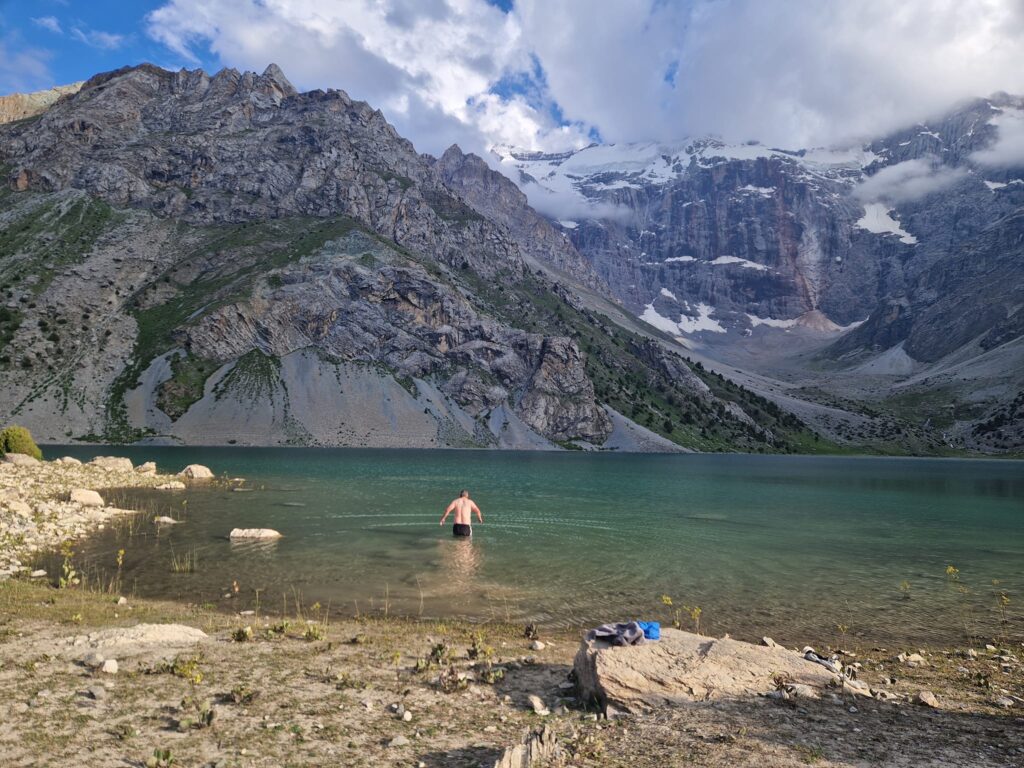
Scenery: Expect breathtaking views of snow-capped peaks, alpine meadows, deep valleys, and glaciers. Honestly, the views in this region of Tajikistan are out-of-this-world! And the best part, you will get to enjoy such views almost entirely all to yourself. Now that is pretty rare these days.
Remoteness: While the Fann Mountains offer some of the most popular hikes in the world, there are still plenty of opportunities for more off-the-beaten-path adventures in remote, less-travelled areas. One day we did not follow any specified trail and simply spent the day wandering around our camp, exploring the most pristine, turquoise lakes you will ever witness. As another hiker put it “It’s the most beautiful playground, enjoy it”
Overall, hiking in the Fann Mountains offers diverse routes suitable for trekkers of various skill levels, and we couldn’t have chosen a more beautiful part of the world to experience our first multi-day hike.
8. What are the water sources along the trail, and should I carry extra water?
As just mentioned, hiking the Fann Mountains is pretty remote and we highly recommend downloading the app OsmAnd. Not only does this app display the different routes available but it also shows available water sources in the area.

Given that we were embarking on a 6-day hike in the Fann Mountains, carrying water for this length of time would have been unrealistic so knowing where water springs in the Fann Mountains was essential.
Be sure to download the Tajikistan map in the app before starting your Fann Mountain hike to use it without coverage.
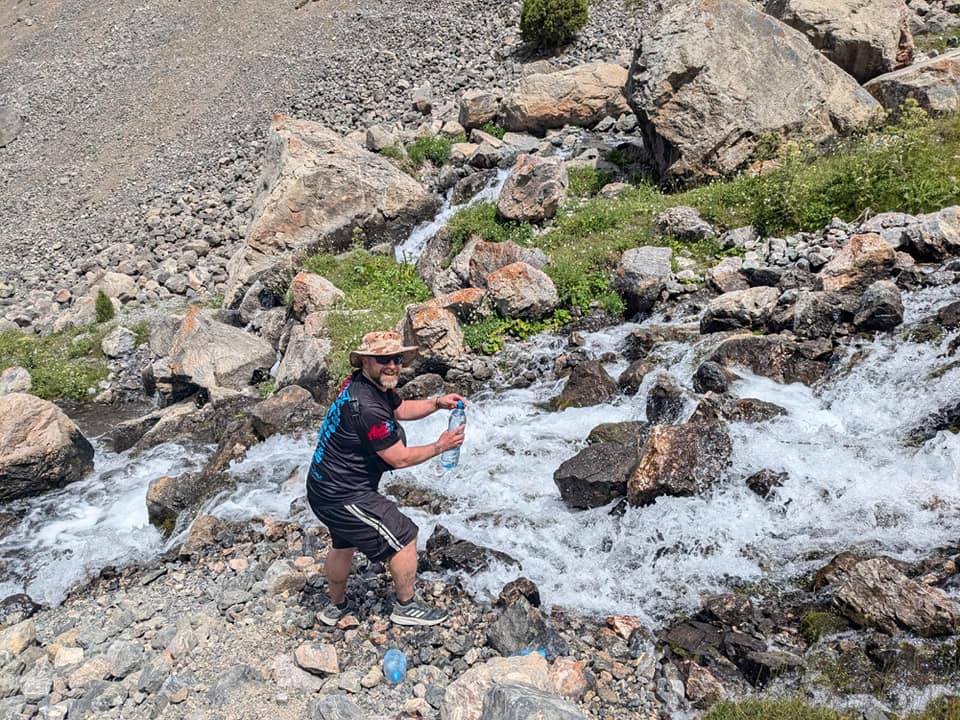
It’s worth mentioning that while Kate from Happy Irish Wanderers felt perfectly fine during the Fann Mountain trek, Kevin experienced an upset stomach. The cause, whether from the water source or something else, remains uncertain. To avoid potential waterborne illness in Tajikistan, it’s a good idea to bring a water purifier as a precaution.
While you are preparing for your Tajikistan trip, check out the best things you need to know before you visit.
9. What’s the altitude, and are there any risks of altitude sickness?
The Fann Mountains reach elevations over 5,000 meters. Be sure to do your research about altitude sickness risks and how to acclimatize properly.
We decided to stay an extra night at the breath-taking Kulikalon Lake to acclimatize, which really we weren’t complaining about! We also brought medication like paracetamol to help with any headaches caused by the high altitude.
10. Are there any local guides or trekking agencies that I should hire?
As mentioned we hiked the Fann Mountains independently, however, during our 6-day hike we met many other trekkers having hired local guides along with donkeys carrying their gear.
Therefore, there really are options for all levels of fitness and hiking experience to enjoy the Fann Mountains trek.
Consider enquiring at your accommodation for more information regarding a reputable local guide.
If you would prefer to have all the hassle taken care of for you – we are talking donkeys for carrying all the gear, all meals prepared for you, and a guide to lead the way – consider booking this ultimate 10-day Fann Mountains hiking tour.
11. What wildlife should I be aware of?
Ask your guide about any dangerous or protected animals in the region (e.g., snow leopards, wolves) and how to handle encounters safely.

We didn’t encounter any wildlife when hiking the Fann Mountains, but we did hear reports from other hikers about dog attacks. Be cautious and avoid approaching working dogs, as they may not be as accustomed to people.
Check out some of our other hikes around the world, such as Mount Longonot in Kenya, Mount Bromo, Indonesia, and the famous Living Root Bridges of India.
12. Where can I find accommodation, and what are the camping options/fees?
In the risk of repeating ourselves, it’s important to emphasize that hiking the Fann Mountains will be a remote experience, and accommodation options will be little to none. With this in mind, it’s essential to be mostly self-sufficient during your hike.
In saying that, the Fann Mountains are home to many friendly shepherds in the summer, so don’t hesitate to greet them and accept a cup of tea if offered!
The Mountaineering and Tourist Camp “Artuch”, also known as Al’pinisttskaya Turisticheskaya Baza is the perfect base for hiking the Fann Mountains. The base is situated at an altitude of 2200 meters, surrounded by snow-capped peaks and crystal-clear lakes.

If you are wanting to experience the beauty of the Fann Mountains without any of the hiking hardship you could get transport from Panjakent to the Artuch base camp and soak in the breathtaking surroundings.
There are even short hikes from the base camp which will bring you to the spectacular Chukurak Lakes, we completed this hike from the camp in just 30 minutes one way.
Hikers can book rooms at Artuch Camp, or if you are a budget traveler in Tajikistan you can pitch your tent for $5 per person. This Fann Mountains accommodation offers hot showers and most importantly hot meals whether you are preparing for or recovering from your hiking days.
Make sure to book Artuch base camp in advance to ensure availability. The Fann Mountains is Tajikistan’s most popular hike so places can get booked out easily.
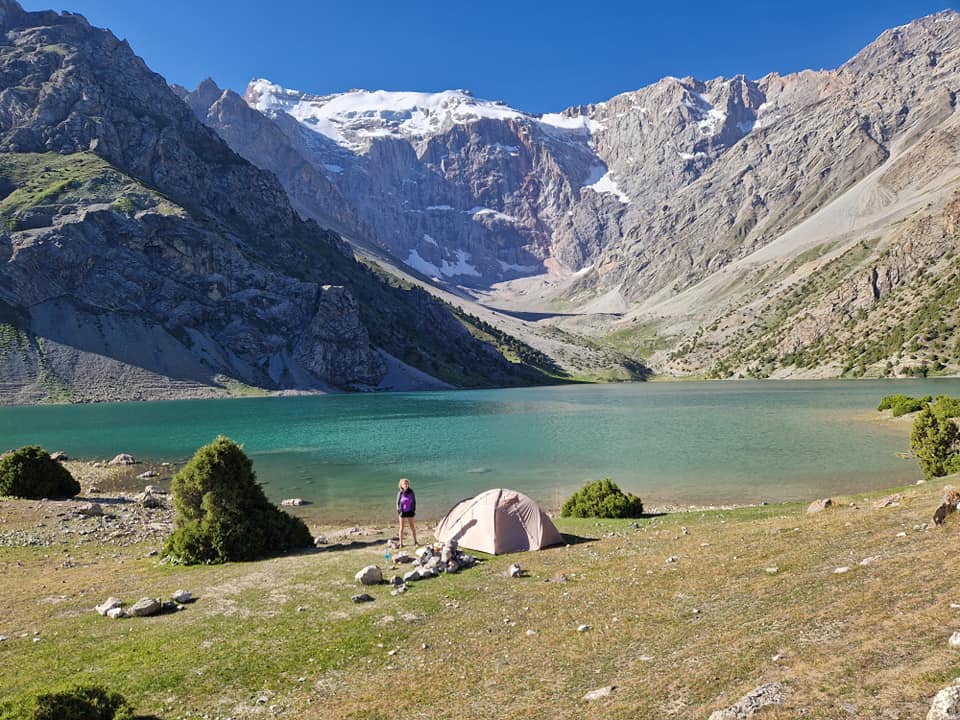
From Artuch base camp, we hiked for 6 hours to Kulikalon Lake at 2,800 meters, which offered one of the most breathtaking views we’ve ever experienced during our travels. However, it will be tents, blow-up mattresses, and tinned food from here on! Trust us, when you wake up to arguably the best views in Tajikistan, it will be worth the effort.
We didn’t pay for camping during our Fann Mountains trek and were mostly on our own throughout the hike. However, we did hear that locals in some areas may ask hikers for a small fee to pitch a tent. It’s a good idea to bring some cash just in case.
If you plan on booking accommodation in Panjakent, we highly recommend staying at Inn Sogdiana in Panjakent. The host was incredibly helpful, assisting not only with our Fann Mountains hike but also with the Tajikistan registration process and securing our Pamir Highway permit. What a legend!
13. What should I pack for hiking the Fann Mountains?
As with hiking anywhere in the world you will need to pack accordingly when hiking the Fann mountains.
Although you will warm easily when hiking during the day, it gets quite cold in the evenings in the Fann Mountains so make sure to pack lightweight warm gear.
The terrain in the Fann Mountains can be slippery at times, with plenty of loose gravel, so it’s essential to wear sturdy hiking boots to navigate it as safely as possible.
We rented all our camping gear from Salom Hostel in Panjakent and secured a gas cooker at Artuch base camp for $3 per day. Gas cookers are hard to find in Panjakent, so we highly recommend booking one in advance for your Fann Mountain trek if you’re unable to bring your own. We met other hikers who had to survive on cans of sardines for their 6-day Fann Mountains trek – definitely not something we’d recommend!
A Battery Pack is essential to keep your camera or phone alive over this multi-day hike because trust us you won’t get too far without stopping to take photos of this unique Tajikistan landscape.
Of course, toilet paper will come in handy, and make sure to bring a bin bag with you to take away your rubbish – remember to leave no trace in this untouched part of the world.
Pack a medical kit for potential injuries, along with medication for issues like an upset stomach or headaches caused by the high altitude.
And don’t forget to download the OsmAnd app to stay on hiking routes and to find water sources, and consider purchasing a water purifier for such water sources.
These are just a few of our top hiking recommendations. Check out our full list of favorite travel must-haves, many of which will be very useful when hiking the Fann Mountains.
14. What is the nearest town or village for resupply or emergency needs?
Although Artuch Village is the nearest village to the base camp, this is a very remote and local village. Panjakent is where you will receive medical care or stock up on any food/camping essentials.
The distance from Panjakent to Artuch is 60 km (37 miles).
Share your planned Fann Mountains trail and the dates you intend to hike with others for safety purposes.
15. What’s the local cuisine like, and what food should I bring?
When preparing for a trek in the Fann Mountains, you’ll want to pack lightweight, high-energy, and non-perishable food that’s easy to prepare and carry. Here are our top hiking food suggestions:
Dehydrated Meals:
- Options: Pre-packaged dehydrated meals or freeze-dried meals are great for lightweight and easy-to-prepare dinners and lunches. Just add hot water and you’re set.
- Why: They are easy to carry, require little preparation, and provide the calories and nutrients needed for long days of hiking.
Snacks for Energy:
- Nuts and Trail Mix: A mix of nuts, dried fruits, seeds, and a bit of chocolate or granola. These provide healthy fats, protein, and sugar for energy.
- Energy Bars: Granola bars, protein bars, or energy bars are compact, nutrient-dense, and easy to eat on the go.
- Jerky: Beef or turkey jerky is a good source of protein and doesn’t require refrigeration.
Carbohydrate-Rich Foods:
- Instant Oats: Pre-packaged instant oatmeal is an excellent breakfast option. Add hot water, and you’re good to go.
- Rice or Couscous: Quick-cooking rice or couscous is lightweight and can be paired with a protein source like tuna or beans.
- Pasta: Lightweight pasta or noodles are a good base for meals, paired with a packet of sauce or canned vegetables.
Canned or Packaged Proteins:
- Tuna or Salmon: Small cans or foil packets of tuna or salmon can be eaten with crackers or mixed into rice.
- Canned Beans: A lightweight, high-protein option, but be mindful of the weight if carrying several cans.
- Shelf-Stable Tofu: This can be a good vegetarian protein option for those avoiding meat.
Hydration:
- Electrolyte Tablets: These are great for maintaining hydration during long days of hiking. y.
- Instant Coffee or Tea Bags: If you enjoy a morning pick-me-up, bring some lightweight instant coffee or tea, and of course, only in our ever favorite YETI tumbler.
Fruits and Vegetables:
- Dried Fruit: Such as raisins, apricots, apples, or banana chips. They’re compact, lightweight, and a good source of sugar and fiber.
Extras for Taste and Comfort:
- Spices or Seasoning Packs: To enhance the flavor of your meals, bring small sachets of salt, pepper, or other seasonings.
- Crackers or Bread: Lightweight and good for eating with spreads or as a side to meals. You can buy packets of different jams in the supermarket in Pajakent which are lightweight and means that you don’t have to carry around glass jars that take up lots of space. We stocked up on these jams and breads when hiking in the Fann Mountains.
Check out the YouTube video below for a detailed look at our full food stock for the Fann Mountains, which can help you plan your own meal preparation and give you an idea of food costs in Tajikistan.
Tips:
- Packaging: Remove packaging where possible to reduce weight. For example, repack snacks or meals into resealable bags.
- Weight and Space: Focus on high-calorie, nutrient-dense foods that don’t take up much space or add excessive weight.
- Food for the First Few Days: Fresh food like fruits, vegetables, or cheese can be consumed in the early days of the trek before they spoil.
With these hiking food items, you’ll have the energy you need to thoroughly enjoy hiking the Fann Mountains!
16. Is Hiking the Fann Mountains in Tajikistan Worth it?
By now, it’s clear that we wholeheartedly believe hiking the Fann Mountains is worth it 100%. In fact, Tajikistan has become our favorite country in Central Asia, offering some of the most unique landscapes we’ve ever seen.
While the hike can be challenging at times, with proper preparation and a steady pace, the rewards of the Fann Mountains will make every step worthwhile. Like us, you’ll find yourself eagerly sharing the tales of the breathtaking beauty of Tajikistan’s Fann Mountains with everyone you meet.
In fact, why not let us know what you think of our guide to the Fann Mountains and how you got on hiking in this hidden gem of Central Asia? We would love to hear from you.
Feel free to leave a message below or contact us on our socials.
Slán go fóil


This post contains affiliate links. If you click on the links to make a purchase, we will earn a small commission. This is at NO EXTRA COST to you. This is a free way to support us and allow us to continue to create inspiring adventure travel guides.

